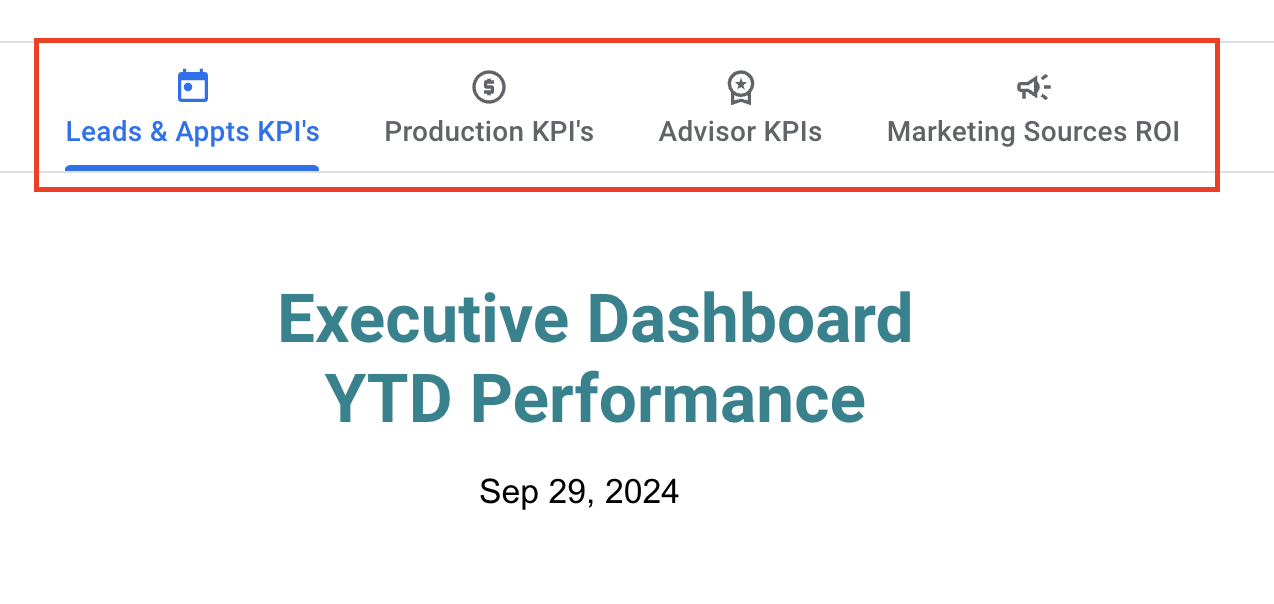Reports
Reports
Executive Reports
Click here to access reports page in LeadCenter.
There are two executive reports in LeadCenter:
Executive reports provide a 360-degree view of the company's sales and marketing performance. That includes leads, appointments, production, and marketing sources.
The difference between both reports is that the YTD covers the period from the beginning of the current year until today, while the full year report covers the entire year from January 1st until December 31st. Using full-year report, you can see current full-year data or previous years. YTD report covers only the current year to date.
The reports contain four pages:

- Lead and appointments key performance indicators (KPIs) page.
- Production KPIs page.
- Advisors KPIs page.
- Marketing sources ROI page.
How do executive reports get populated with data?
Executive reports are automated. The data is populated using various features of LeadCenter.
- Leads are the leads captured in the sales pipeline. Leads that are removed from the sales pipeline will not show in the executive dashboards.
- Appoointments created in the calendar. Appointments created in other connected calendars like Google, Microsoft, or Redtail do not appear in the executive reports.
- Accounts created in the accounts. To create an account, go to the contact details page, click on the Actions menu, and click Create account.
- Marketing spend created in the marketing expenses page.
- Goals created in the marketing goals page.
Dimensions and metrics definitions
YTD report column definitions
The YTD report will show metrics for:
- Last 7 days.
- Last 30 days.
- Year to date.
- Percentage of change of year-to-date metrics versus last year.
- Percentage of progress against goal.
- The goals for the year.
Full-year report column dimensions definitions
The full report has the following columns:
- Year: this will show the metrics for the selected year
- Previous year: This will show the same metrics attained last year.
- % Change from previous year: (This year metric - previous year metric) / previous year metric.
- Goal: The goal set for the metrics in the marketing goals page.
- Goal %: metric attainment against goal. It is equal to metric / goal.
I. Lead and appointment KPIs page definitions
1. Leads scorecard table
The number of leads generated in the period and conversion of leads to appointments and clients. It is important to note that this table is based on lead created at field in the period. For example, in the YTD report, this section will show only leads created year-to-date. Subsequently, it will show only appointments, and became clients for those leads. Below is the list of definitions for each dimension:
- New leads: the new leads generated in the period (YTD or full year).
- 1st appointment set from new leads: 1st appointment set with new leads in the period (YTD or full year). This will show only appointments with the category 1st visit - Not a Client.
- 1st appointment kept from new leads: Shows the total number of leads who booked a 1st appointment and attended it in the period (YTD or full year). You don't have to mark an appointment completed. Any appointment that is not canceled or marked No show is assumed kept by the system. If the contact cancels the appointment, cancel it. If the contact did not show, mark it no-show.
- Became client from new leads: The won leads in the period (YTD or full year) and are set to a won stage. This is regardless of whether the lead attended appointments or not. For example, if a lead is created in the system and the stage is set to won without booking any appointment, that lead will show up in this report.
- Became client (HOH) from new leads: The head of household leads that came in the period (YTD or full year) and are set to a won stage.
- Cost per lead: It is calculated based on total marketing spend / total number of leads in the period.
- Cost per 1st appointment kept: It is calculated based on total marketing spend / total number 1st appointments kept in the period.
- Customer acquisition cost (CAC) - HoH: total marketing spend / total head of household leads converted to the stage won.
- Lead conversion ratio to 1st appointment: number of 1st appointments / number of leads in the period.
2. 1st appointments table
This table focuses on 1st appointments booked in the period (YTD or full year). It is important to note that this table is based on 1st appointment date field in the period. For example, in the YTD report, this section will show only appointments created year-to-date regardless of when the lead was created. Subsequently, it will show only appointments and became clients for those appointments. Below is the list of definitions for each dimension:
- 1st appointment set: 1st appointment set in the period (YTD or full year). This will show only appointments with the category 1st visit - Not a Client.
- 1st appointment kept: Shows the total number of 1st appointments booked and attended in the period (YTD or full year).
- Became client: The won leads in the period (YTD or full year) after attending the first appointment in the period.
- Became client (HOH): The won head of household leads in the period (YTD or full year) after attending the first appointment in the period.
- Pending: The total open leads that attended 1st appointment in the period and are still in an open stage.
- Stick Ratio % : is 1st appointments kept / 1st appointments booked in the period.
- Became Client %: Percentage of prospect won after attending 1st appointment in the period.
3. Total New Clients
Measure the total prospects that became clients in the period. This is based on the contact stage set won and the closed at date. This is independent of when the lead came or the appointment date. It is only based on the contact closed at date.
4. Total New Head of Household Clients
Same as total new clients, but filters out contacts that are not head of household.
II. Production KPIs page definitions
1. Production performance (issued)
Accounts issued in the period by business type based on account issued date
2. Production Performance (pending)
Accounts pending by business type based on the application signed date.
2. Production Performance (forecasted)
You can use forecasted as a middle stage between pending and issued. Forecasted accounts are the accounts that writing advisors think that it has a high probability of closing. Set the forecasted date for each account under the operations tracking card on the account details page.
III. Advisors KPIs page definitions
Advisors KPIs page is similar to the production KPIs page. But it splits production per advisor.
IV. Marketing sources ROI page definitions
Marketing sources ROI page provides a details tracking of performance per marketing source. There are two tables on this page: a summary table and detailed tables below it. Below are the column definitions for both tables:
- Spend amount: marketing spend per marketing source in the period (YTD or full year). The total spend for all sources is in the bottom row.
- Lead count: Total leads generated per marketing source in the period.
- Cost/lead: cost per lead per source. This is calculated by dividing marketing expenses by the number of leads per source.
- % Leads: The percentage of leads generated from a marketing source. The formula for this dimension is total lead from source / total leads in the period.
- 1st appointment booked: Total first appointments booked from leads generated in the period per source.
- Cost / 1st appointment booked: cost per 1st appointment booked in the period per source.
- 1st appointment kept: Total first appointments booked and kept from in the period per source.
- % 1st appointment kept: Percentage of 1st appointment kept from a source / total 1st appointment kept from all sources.
- Cost / 1st kept: Cost per 1st appointment booked and kept in the period per source.
- Became client: Total number of leads generated from a source in the period and became client (the stage is set to won).
- Became client HoH: Total number of head of household leads generated from a source in the period and became client (the stage is set to won)..
- % Share become client: Percentage of became clients from a source / total became clients from all sources.
- CAC (HoH): Head of household customer acquisition cost per source.
- Amounts issued: Total amounts issued per source including annuities and investments.
- Aum issued: Total assets under management issued in the period per source.
- Insurance issued: total insurance accounts issued per source in the period.
- ROI: Return on investment per source. The formula for calculating ROI is the total amount issued per source / total marketing spend per source.

Need more help?
If you can’t find the answers you’re looking for, our support specialists are available to answer your questions and troubleshoot if necessary.
-
Phone Call (888) 291-7116. Our main hours are Monday to Friday 7 am-5 pm Central Time.
-
Support Ticket Send your questions and inquiries via email to support@leadcenter.ai. A support ticket will be created and one of our team members will get back to you as quickly as possible.
